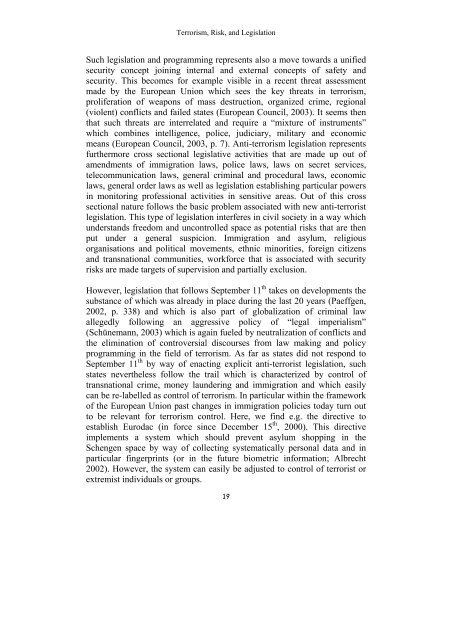222467to222472
222467to222472
222467to222472
Create successful ePaper yourself
Turn your PDF publications into a flip-book with our unique Google optimized e-Paper software.
Terrorism, Risk, and Legislation<br />
Such legislation and programming represents also a move towards a unified<br />
security concept joining internal and external concepts of safety and<br />
security. This becomes for example visible in a recent threat assessment<br />
made by the European Union which sees the key threats in terrorism,<br />
proliferation of weapons of mass destruction, organized crime, regional<br />
(violent) conflicts and failed states (European Council, 2003). It seems then<br />
that such threats are interrelated and require a “mixture of instruments”<br />
which combines intelligence, police, judiciary, military and economic<br />
means (European Council, 2003, p. 7). Anti-terrorism legislation represents<br />
furthermore cross sectional legislative activities that are made up out of<br />
amendments of immigration laws, police laws, laws on secret services,<br />
telecommunication laws, general criminal and procedural laws, economic<br />
laws, general order laws as well as legislation establishing particular powers<br />
in monitoring professional activities in sensitive areas. Out of this cross<br />
sectional nature follows the basic problem associated with new anti-terrorist<br />
legislation. This type of legislation interferes in civil society in a way which<br />
understands freedom and uncontrolled space as potential risks that are then<br />
put under a general suspicion. Immigration and asylum, religious<br />
organisations and political movements, ethnic minorities, foreign citizens<br />
and transnational communities, workforce that is associated with security<br />
risks are made targets of supervision and partially exclusion.<br />
However, legislation that follows September 11 th takes on developments the<br />
substance of which was already in place during the last 20 years (Paeffgen,<br />
2002, p. 338) and which is also part of globalization of criminal law<br />
allegedly following an aggressive policy of “legal imperialism”<br />
(Schünemann, 2003) which is again fueled by neutralization of conflicts and<br />
the elimination of controversial discourses from law making and policy<br />
programming in the field of terrorism. As far as states did not respond to<br />
September 11 th by way of enacting explicit anti-terrorist legislation, such<br />
states nevertheless follow the trail which is characterized by control of<br />
transnational crime, money laundering and immigration and which easily<br />
can be re-labelled as control of terrorism. In particular within the framework<br />
of the European Union past changes in immigration policies today turn out<br />
to be relevant for terrorism control. Here, we find e.g. the directive to<br />
establish Eurodac (in force since December 15 th , 2000). This directive<br />
implements a system which should prevent asylum shopping in the<br />
Schengen space by way of collecting systematically personal data and in<br />
particular fingerprints (or in the future biometric information; Albrecht<br />
2002). However, the system can easily be adjusted to control of terrorist or<br />
extremist individuals or groups.<br />
19


